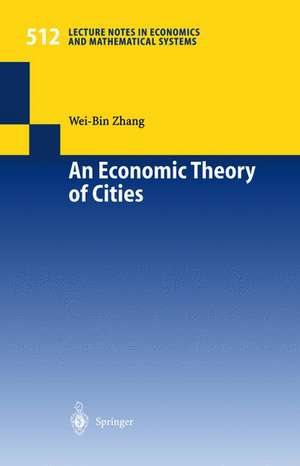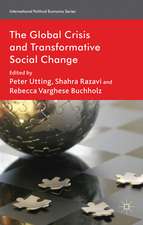An Economic Theory of Cities: Spatial Models with Capital, Knowledge, and Structures: Lecture Notes in Economics and Mathematical Systems, cartea 512
Autor Wei-Bin Zhangen Limba Engleză Paperback – 20 noi 2001
Din seria Lecture Notes in Economics and Mathematical Systems
-
 Preț: 360.02 lei
Preț: 360.02 lei -
 Preț: 383.93 lei
Preț: 383.93 lei -
 Preț: 384.09 lei
Preț: 384.09 lei -
 Preț: 380.07 lei
Preț: 380.07 lei -
 Preț: 446.26 lei
Preț: 446.26 lei -
 Preț: 497.37 lei
Preț: 497.37 lei -
 Preț: 380.84 lei
Preț: 380.84 lei -
 Preț: 384.86 lei
Preț: 384.86 lei -
 Preț: 378.34 lei
Preț: 378.34 lei -
 Preț: 399.67 lei
Preț: 399.67 lei - 20%
 Preț: 360.93 lei
Preț: 360.93 lei - 15%
 Preț: 643.16 lei
Preț: 643.16 lei -
 Preț: 379.09 lei
Preț: 379.09 lei -
 Preț: 404.74 lei
Preț: 404.74 lei -
 Preț: 385.62 lei
Preț: 385.62 lei - 15%
 Preț: 644.49 lei
Preț: 644.49 lei -
 Preț: 379.09 lei
Preț: 379.09 lei -
 Preț: 345.50 lei
Preț: 345.50 lei -
 Preț: 425.80 lei
Preț: 425.80 lei -
 Preț: 378.34 lei
Preț: 378.34 lei - 18%
 Preț: 775.65 lei
Preț: 775.65 lei -
 Preț: 392.60 lei
Preț: 392.60 lei -
 Preț: 401.61 lei
Preț: 401.61 lei - 15%
 Preț: 646.43 lei
Preț: 646.43 lei -
 Preț: 382.18 lei
Preț: 382.18 lei -
 Preț: 378.34 lei
Preț: 378.34 lei - 15%
 Preț: 637.59 lei
Preț: 637.59 lei - 15%
 Preț: 647.27 lei
Preț: 647.27 lei -
 Preț: 377.73 lei
Preț: 377.73 lei -
 Preț: 447.84 lei
Preț: 447.84 lei - 15%
 Preț: 644.49 lei
Preț: 644.49 lei -
 Preț: 386.00 lei
Preț: 386.00 lei - 15%
 Preț: 654.43 lei
Preț: 654.43 lei -
 Preț: 415.02 lei
Preț: 415.02 lei -
 Preț: 411.54 lei
Preț: 411.54 lei -
 Preț: 398.92 lei
Preț: 398.92 lei -
 Preț: 398.92 lei
Preț: 398.92 lei -
 Preț: 392.75 lei
Preț: 392.75 lei - 15%
 Preț: 635.47 lei
Preț: 635.47 lei - 20%
 Preț: 653.56 lei
Preț: 653.56 lei -
 Preț: 379.86 lei
Preț: 379.86 lei -
 Preț: 495.46 lei
Preț: 495.46 lei -
 Preț: 447.99 lei
Preț: 447.99 lei -
 Preț: 378.71 lei
Preț: 378.71 lei - 15%
 Preț: 637.13 lei
Preț: 637.13 lei -
 Preț: 385.84 lei
Preț: 385.84 lei -
 Preț: 378.54 lei
Preț: 378.54 lei - 15%
 Preț: 666.55 lei
Preț: 666.55 lei -
 Preț: 380.07 lei
Preț: 380.07 lei
Preț: 385.08 lei
Nou
Puncte Express: 578
Preț estimativ în valută:
73.68€ • 76.93$ • 60.98£
73.68€ • 76.93$ • 60.98£
Carte tipărită la comandă
Livrare economică 04-18 aprilie
Preluare comenzi: 021 569.72.76
Specificații
ISBN-13: 9783540427674
ISBN-10: 3540427678
Pagini: 244
Ilustrații: XI, 228 p.
Dimensiuni: 155 x 235 x 13 mm
Greutate: 0.35 kg
Ediția:Softcover reprint of the original 1st ed. 2002
Editura: Springer Berlin, Heidelberg
Colecția Springer
Seria Lecture Notes in Economics and Mathematical Systems
Locul publicării:Berlin, Heidelberg, Germany
ISBN-10: 3540427678
Pagini: 244
Ilustrații: XI, 228 p.
Dimensiuni: 155 x 235 x 13 mm
Greutate: 0.35 kg
Ediția:Softcover reprint of the original 1st ed. 2002
Editura: Springer Berlin, Heidelberg
Colecția Springer
Seria Lecture Notes in Economics and Mathematical Systems
Locul publicării:Berlin, Heidelberg, Germany
Public țintă
ResearchCuprins
1 Introduction.- 1.1 Von Thünen’s Theory.- 1.2 Classical Location Theory.- 1.3 The Alonso Model and its Extensions.- 1.4 Imperfect Competition.- 1.5 Spatial Agglomeration.- 1.6 Spatial Structures with Population and Knowledge.- 1.7 City Systems.- 1.8 Nonlinear Spatial Economic Dynamics.- 1.9 The Purpose and Structure of the Book.- 2 Urban Growth with Housing and Spatial Structure.- 2.1 Urban Growth with Housing Production.- 2.2 The Dynamics in the Terms of K(t).- 2.3 Equilibrium and Stability.- 2.4 The Impact of the Population on Economic Geography.- 2.5 The Propensity to Hold Wealth and the Equilibrium Structure.- 2.6 On Extensions of the Basic Model.- 3 Spatial Pattern Formation with Capital and Knowledge.- 3.1 The Urban Dynamics.- 3.2 Equilibrium and Stability.- 3.3 The Knowledge Accumulation Parameters.- 3.4 The Impact of Government Intervention in Research.- 3.5 The Working Conditions of Scientists.- 3.6 On Knowledge Creation and Spatial Economic Evolution.- 4 Urban Structure with Growth and Sexual Division of Labor.- 4.1 Growth with Sexual Division of Labor and Location.- 4.2 The Spatial Equilibrium Structure.- 4.3 Sexual Productivity Differences and Economic Structure.- 4.4 Remarks.- A.4.1 Proving Proposition 4.2.1.- 5 Dynamic Urban Pattern Formation with Heterogeneous Population.- 5.1 The Urban Growth with Two Groups.- 5.2 Separation of the Groups’ Residential Location.- 5.3 Economic Equilibrium and Stability.- 5.4 The Impact of Savings Rates.- 5.5 The Impact of Human Capital.- 5.6 On Urban Evolution with Multiple Groups.- 6 Two-Group Spatial Structures with Capital and Knowledge.- 6.1 The Spatial Economy with Heterogeneous Population.- 6.2 Temporary Urban Pattern.- 6.3 Long-Run Equilibria and Stability Conditions.- 6.4 The Impact of Creativity.- 6.5 TheImpact of the Population.- 6.6 On Urban Evolution with Heterogeneous Population.- 7 Urban Growth and Pattern Formation with Preference Change.- 7.1 The Model.- 7.2 Properties of the Dynamic System.- 7.3 Human Capital and the Economic Structure.- 7.4 On Preference Change and Urban Pattern.- 8 Urban-Rural Division of Labor with Spatial Amenities.- 8.1 The Spatial Structure with Urban-Rural Areas.- 8.2 Spatial Equilibria.- 8.3 Amenities and Economic Geography.- 8.4 On Spatial Equilibrium Structure.- 9 Spatial Equilibrium with Multiple Cities.- 9.1 The Model.- 9.2 Urban Equilibria.- 9.3 The Impact of Amenities upon the Urban Structure.- 9.4 Concluding Remarks.- 10 Growth with International Trade and Urban Pattern Formation.- 10.1 The Model.- 10.2 The Dynamic Properties of the Trade System.- 10.3 Country 1’s Propensity to Own Wealth.- 10.4 Country Ps Working Efficiency.- 10.5 On International Trade and Spatial Structures.- 11 Nonlinear Dynamics of a Multi-City System.- 11.1 An Isolated Island Economy.- 11.2 Economic Geographic Cycles in the Isolated Island Economy.- 11.3 Aperiodic Oscillations in the J-Island Economy.- 11.4 On Spatial Chaos.- 12 Further Issues on Cities.- Author Index.
















